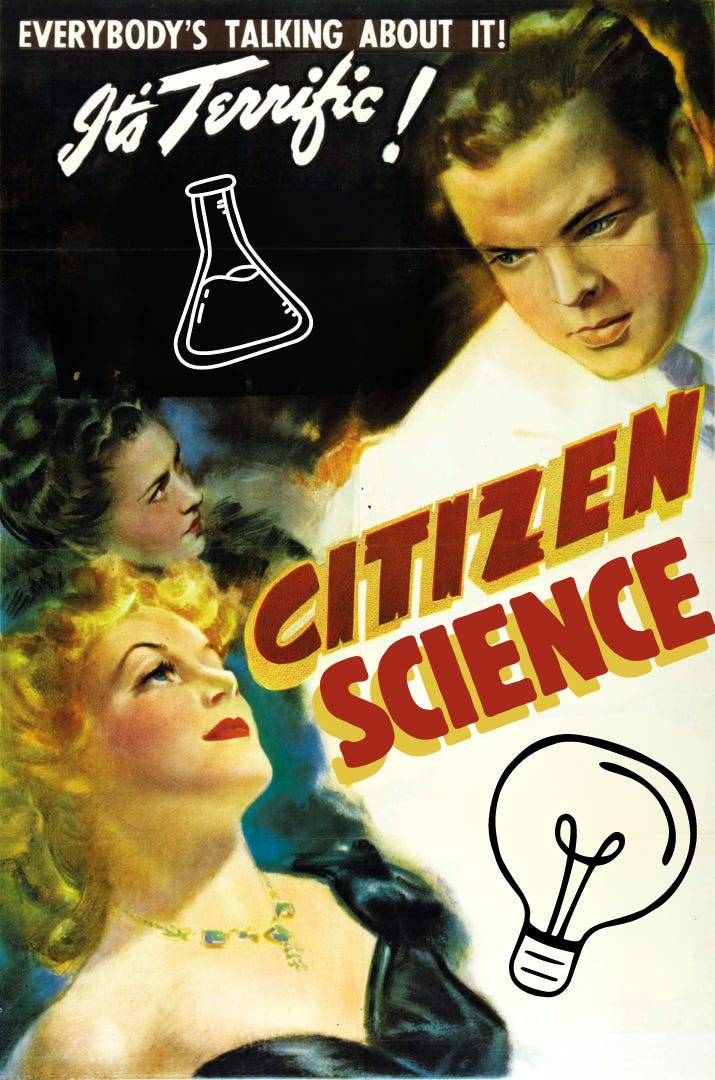I truly believe that we are all bona fide scientists. The “scientific method” is simply observing the world, generating an understanding about how the world works, testing your new inference, and determining if you were correct. This approach is an everyday human experience, even if we don’t consider it as science. Maybe you rig up a new watering scheme for your garden, or you make a slight tweak to a recipe, or you grab a new nutritional supplement to overcome the existential dread of existence in 2024. No matter the specific situation, the thought mechanics are the same as we use in the lab.
At some point, an artificial line arose between the science done in the lab and the science done in the community. Lab science became privileged and gatekept by specialized training programs administered by higher education. Yet, the boundary is flimsy, and today we are knocking it down.
And we aren’t the only ones trying to discard this false dichotomy. In recent years, scientists have been seeking the help of folks outside the lab to observe wildlife, process large amounts of data, and track climatic shifts. These projects have taken on the moniker of “citizen science” because the bulk of the work is completed by community members rather than stuffy scientists.
The reach of these projects is vast. A 2015 analysis of citizen science endeavors in biodiversity research estimated that 1.3-2.3 million volunteers annually contribute to just 388 projects. Individual volunteers spent an average of only 24 hours per year collecting biodiversity data. Collectively, the value of this labor was estimated to be between $667 million and $2.5 billion annually.
Since then, the possibilities for citizen science have only expanded. The COVID-19 pandemic saw multiple community-engaged health projects in both research and public health efforts (such as vaccination campaigns, contact tracing, etc.). These efforts were vital to the health of our communities and continue to be essential components of social support. Regardless of what the future holds for us as a species, these community-based approaches to wellbeing are tried and true tactics that allow us to use our innate science skills to work together for the common good.
citizen science example from recent history
A major mobilization of citizen scientists occurred after the United States government passed the Clean Water Act (CWA) in 1972. Among other things, the act requires states to monitor the quality of their surface water. However, this presented states with a major problem: How do you consistently monitor every lake, river, and stream within a state’s borders?
Minnesota and Maine were the first states to identify a sustainable solution. The states trained local groups to test water quality and provided the testing equipment to handle the nearby bodies of water. By 1975, citizen testers in Minnesota voluntarily managed the monitoring of 250 lakes. Other states replicated the program to handle federal testing requirements.
Citizen scientists continue to play an indispensable role in monitoring water quality, despite recent loosening of the CWA’s purview. In 2023, the Supreme Court decided Sackett v. Environmental Protection Agency that wetlands are not covered by the CWA. According to Earthjustice, who filed a brief in the case on behalf of 18 Tribes, the ruling threatens over 59 million acres of wetlands. Without federal protection, these waterways will rely on local citizens as their best advocates in the face of industries eager to pollute.
In this way, citizen science can be performed through both formal networks (such as state-led monitoring of water quality) and informal networks (local whistleblowers calling out environmental misdeeds by corporations). Both approaches are legitimate uses of science. While our governments fund most of the science that is pursued, citizen science be a site of community pushback against milquetoast enforcement of environmental standards and even pure underregulation. The citizen is inherently political and so is the citizen’s science.
so you want to citizen science?
There are so many ways to get involved in citizen science efforts near you. Check out your local parks for formal or informal groups that help with maintenance and monitoring of local wildlife. Sign up to respond to health surveys led by major, well-funded data banks like The Pride Study. See if your local public health agency is taking volunteers for their latest initiatives.
Or, participate in QSL’s own citizen science initiative by submitting your anonymous recommendations to improve medical training in queer health. The survey is still open for you to share your thoughts in just 5 min. All LGBTQIA2S+ folks are welcome to contribute regardless of your country of origin. The more people who respond, the more powerful our conclusions will be! There are also opportunities to get involved in the analysis of the data if you want.
Last, you can also search catalogs of citizen science projects that are actively recruiting participants. The United States government has a comprehensive catalog of formal projects looking for volunteers. Some projects are location based, but others are recruiting folks from around the world. Subjects range from ecology to health to astronomy to computer science. The European Union, the Australian Citizen Science Association, CitSci India, CitSci Africa, and Zooniverse all have similar databases to help folks get involved with interesting citizen science projects near you.






